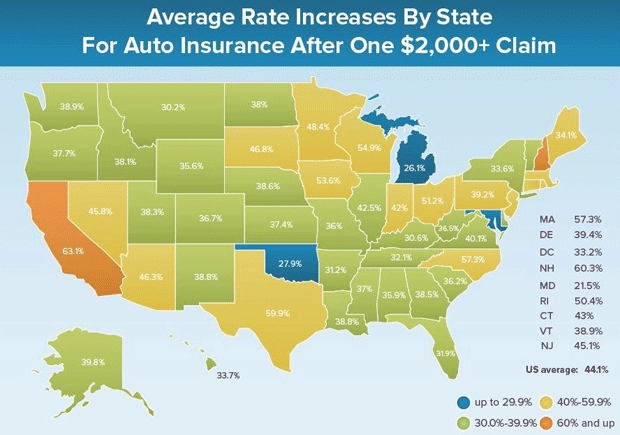The big hit that comes after a car accident
If you filed a car accident claim in California last year, be prepared for your auto insurance premium to soar as much as 63 percent -- or nearly $500 -- in 2017. That’s the ugly reality, according to the website insurancequotes.com, which offers free insurance quotes and conducts an annual survey of the added cost after filing car insurance claims.
“It probably comes as no surprise to most drivers that filing an auto insurance claim will likely result in a premium spike,” according to the study. “However, the extent of those increases -- and their steady year-over-year incline -- may seem staggering.”
So just how bad is the bad news? The survey took a hypothetical 45-year-old married woman who was employed and had an excellent credit score and accorded her a $2,000-plus accident. Then the survey looked at insurers in all 50 states and the District of Columbia to see how much her premium would rise (see map at bottom). The answer: an average 44 percent. And that’s a 6 percent jump from just three years ago.
But the bad news gets worse. Filing a second claim in the same year boosts an annual premium nearly 100 percent, or 13 percent more than in 2014.
“Bottom line, insurers see drivers who have multiple accidents as high risk and will price that risk accordingly,” said Loretta Worters, a spokeswoman for the Insurance Information Institute (III), which represents the industry.
The survey also rated bodily injury claims against damage claims and claims against comprehensive coverage, which is generally not mandatory and covers losses such as theft and vandalism.
Not surprisingly, bodily injury claims raise premiums the most -- nearly 50 percent, far more than damage or comprehensive claims. The average bodily injury costs more than $17,000, while automotive damage averages about $3,500. Bodily injury claims declined for many years until 2015, when they spiked 8 percent spike over the previous year, according to the National Safety Council. That rose again to 9 percent in the first half of 2016 and continues to trend higher each year.
Even more bad news is on the horizon for both good and bad drivers. The nation’s largest insurer of both cars and homes, State Farm, just reported a $7 billion underwriting loss on its auto insurance. That’s almost a guarantee that other car insurers will raise rates more than they already have, and will likely charge drivers who’ve had accidents even more for that poor performance.
“For insurers, bad news always turns into good news,” said Robert Hunter, director of Insurance for the Consumer Federation of America and a frequent critic of the industry. “It’s a good reason to raise rates.”
The average rate for someone filing a single claim has risen about six percentage points since 2014, according to the survey.
Hunter said he has no problem with insurers charging more for drivers who’ve had accidents, particularly when they were at fault. California -- the state that charges the most -- also requires insurers not to use credit scoring and other factors when deciding rates. “The most important thing ought to be your driving record,” said Hunter. “Stay clean, and keep it low.”
But it’s not always possible. While, in theory, an accident that isn’t your fault has to be reported and paid for by the other driver’s insurance company, this may not be the case when lawyers get involved. It could also depend on the police officer who wrote the accident report.
“Assigning fault in an accident is rarely a zero-sum process where one driver is 100 percent at fault and the other driver is zero percent,” said the III’s Worters.
So does this survey offer any good news? Well, yes. A single comprehensive claim, such as for someone throwing a rock through your windshield and damaging your car’s interior, results in an average premium increase of less than 2 percent. That’s because insurers don’t regard this as your fault and because the average comprehensive claim is less than $1,700.
While states like California, New Hampshire and Texas, where certain speed limits exceed 75 miles per hour, had higher premium rate increases after an accident than the national average, others like Maryland, Michigan and Oklahoma were lower, primarily due to insurance regulations that allow for “nondriving factors” such as marital status and credit rating.
Anyone who had an accident can shop around for another insurer with a better rate, said Worters, and some car carriers rate accidents less severely than others in terms of premiums. But your driving record is an open book for all insurers to see. It may also help to take a defensive driving course.
Overall, premiums are trending upward, and drivers who’ve had accidents will likely take the biggest “hit,” since more accidents, fatal and otherwise, are happening all the time. The cost, even when injuries aren’t involved, is also rising, partly due to increased technology found in newer vehicles. Car damage repair costs rose nearly 15 percent in the two years since 2014.
The rationale for the increase in accidents and their rising costs has two schools of thought. One is that Americans drove 3.2 trillion miles last year -- much more than during the recession years of 2008 to 2012 -- and that has inevitably caused more casualties. The other is that the “epidemic” of cell phones, tablets and other tech devices that drivers use in connected cars has distracted them and their driving.
But one thing is for sure. If drivers ever needed an incentive to stay off the cell phone, they should keep in mind what happens after an accident.




